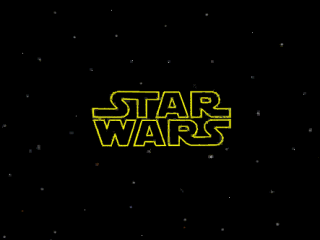A Brief History of Science Fiction Film Music
References, Links, and Works Cited
Created by Jessica Rooney
Last updated 5/1/06


Star Wars: A New Hope (1977)
Use of Music to Draw Audience into the World of Star Wars
Throughout the film, music pulls the audience into the world of Star Wars by evoking emotions that make situations and landscapes recognizable. This essentiality of the music is evident at the very beginning of the film, where music is used to immediately to immerse the audience in a sonic environment that mentally transports them to a “galaxy far, far, away.”
This musical passageway actually begins with a moment of silence as the words “A long time ago, in a galaxy far, far, away” appear on a black screen. The silence functions to hold the audience in suspense, making them almost apprehensive it seems to signal that the following scene will either be very good or very bad. This expectation is met with a fantastic fanfare, bringing in a reminder of an “earlier ‘heroic’ era of filmmaking” (Buhler 33). The opening silence is not the only important absence in the title music, however. The chords are incomplete, emphasizing the root without the third or fifth, the two chordal tones usually used to designate a chord as major or minor (Buhler 36). But even without these two tones the chord sounds major, adding a sense of mystery and age. Similarly, the music ends on the dominant, a chordal tone that naturally leads to a cadential ending. But because the music does not resolve to the tonic chord the music feels unresolved, just as the text leaves “much unexplained” (Buhler 37). And just as the music began immediately with the appearance of the title, it moves away with the text, giving it this sense of purposeful motion. From this moment Star Wars is given a “mythic aura” born of the “synchronization of music and image” (Buhler 33).
While the chordal structure of the fanfare has musical holes, the orchestration is well balanced. The trumpets and horns have the blaring melody, leaving the lower brass to secure the bass of sound and the strings and woodwinds to compliment the bright upper tones of the brass. Similarly, the composition is solid, initiating the “melodic impulse” first through rhythms and then through pitch (Buhler 36). Accordingly, the fanfare gives the feeling that it is progressing naturally and strongly towards a definite end. This feeling of certainty is strengthened by the fact that the fanfare seems to be an extension of Alfred Newman’s Twentieth Century-Fox Fanfare. The fanfare that accompanies Twentieth Century-Fox’s logo at the very beginning of the film ends cleanly in a dramatic gesture that helps highlight the silence, and by starting in the same key and tonality as Newman’s fanfare ended, the Star Wars fanfare bridges the gap of silence and makes it seem as a continuous whole (Buhler 36).
After such a fanfare, the audience has no choice but to be pulled into the film even before the action is presented. The unresolved but still natural chords leave the audience feeling a need to resolve tension by finding out more of the story, committing themselves mentally to become immersed in the scenes that will reveal the plot. Similarly, there is a personal emotional response to the opening chords. The triumphant use of brass and driving triplet rhythms leave the audience feeling excited, hopeful, and heroic. This confidence helps them to release the security of what they know to be real and to accept the unknowns being presented visually.
The fanfare also sets up an important precedent for the use of music in Star Wars. Music precedes the narrative of the story and “calls it into being” (Buhler 36), establishing music’s role as a mythic herald of truth. Similarly, the audience knows immediately that music will be what they will turn to for direction, for music manipulates their view from the very beginning. As the camera moves from watching the disappearing letters to swing down and view the spaceships below, the music also loses “tonal coherence” and becomes ambiguous and unstable (Buhler 37). This plunges the audience into the action, no longer on the same all-knowing plane as the music. “Stable tonality is to the ear what the stable camera placement is to the eye” and so once the view changes and the tonality also is lost, “everything becomes subject to interpretation” (Buhler 37). No longer viewers but participators, the audience is now in a position where they can do nothing but accept the science fiction aspects of Star Wars before these aspects are even introduced.
